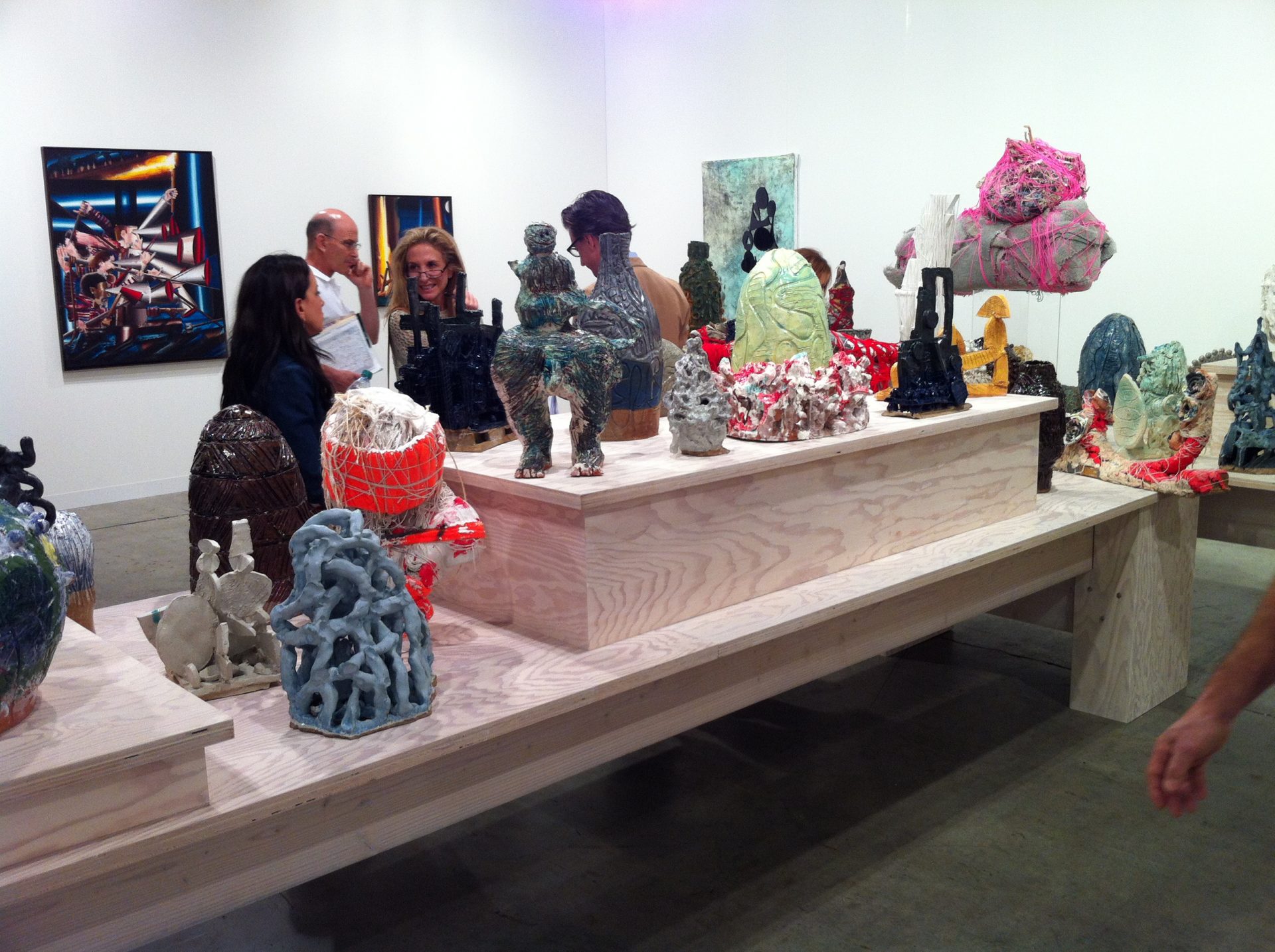MIAMI, FL – Hundreds of hours of shiny black cassette tape pour through a toothy shark jaw suspended from the ceiling in an untitled artwork by Bahamian artist Blue Curry.
This is not the Caribbean art tourists expect to find on their hotel walls or in gift shops.
A new exhibit showcasing Curry and 22 other Caribbean-born contemporary artists intends to expand the imagery associated with the archipelago of tropical islands between Florida and South America.
“It’s not folk art. It’s not souvenirs,” said Miami-based Haitian artist Edouard Duval-Carrie, curator of “The Global Caribbean” exhibit.
“It’s real art based on very deep historical, psychological, social, economic upheavals and movements that make this region quite a fascinating one,” he said.
The exhibit opened Friday as part of Art Basel Miami Beach, the annual four-day contemporary art fair that draws collectors to the Miami area. “The Global Caribbean” is being staged in a new cultural center in Miami’s gritty Little Haiti district.
Caribbean contemporary artists are seldom seen in the international art market, and “The Global Caribbean” presents their work both to regional communities and to a wider audience, said officials from Culturesfrance, a French government agency whose initiatives in the islands led to the exhibit.
The 23 artists are linked by their Caribbean heritage – hailing from Cuba, Martinique, Haiti, Jamaica, the Bahamas, Barbados, Guyana, Trinidad, Guadeloupe, the Dominican Republic and Puerto Rico – though many now live in the U.S., Canada and Europe.
The exhibit includes photography, paintings, sculptures and video installations. Duval-Carrie said each artist was selected to illustrate the region’s diverse talents, connections and experiences with natural disasters, colonization and migration.
Some pieces clearly reference the legacy of slavery on Caribbean plantations. Faceless fabric dolls line up in an untitled installation by Alex Burke of Martinique. Colored pencils before the dolls appear to be oars, and the overall piece evokes a ship of stoic prisoners.
Three canvas prints by Jamaican artist Charles Campbell swirl geometric shapes with knots, bloody hand prints and indistinguishable faces. Combined, the images appear to be a mass of people struggling with an oppression beyond the frame.
The metal wires binding scrap wood, beer bottles and cast-off wheels in two sculptures initially appear as simple nets catching ocean debris. But Jamaican-born Arthur Simms said each material in his two works has a specific meaning: hemp rope for the drugs associated with that island; glass and metal for the superstition in some black communities that reflected light wards off evil; wheels for constant migration throughout the Caribbean. The deceptively rough assembly of each piece is meant to suggest the handmade carts poor Jamaican vendors push to sell their wares in the market.
“It’s about the diaspora, it’s about me leaving Jamaica as a child, it’s about the journey of the Africans coming to this hemisphere,” Simms said.
Some artists’ Caribbean links aren’t immediately apparent. Abstract fan shapes drip down the pastel canvases of Haitian-American painter Vickie Pierre. A series of black and white close-ups by Puerto Rican photographer Betty Rosado of a man’s face, tattoo, chest hair and a prayer card pulled halfway from a pocket reveal his personality but nothing about Caribbean culture.
Hew Locke warns viewers not to assume that the politics underlying many Caribbean artists’ works are always the politics of slavery and social class.
Locke, who grew up in Guyana, bound two adult-sized, seething figures with chains to a much larger horned figure between them in an installation titled “Kingdom of the Blind.”
The work, about the control of power, was created in a post-9/11 context, influenced by the wars being fought by the U.S. and the U.K., where he lives, Locke said.
“Slavery is probably there, because being who I am as soon as I put chains on something it alludes to that, but the chains keep that power in,” Locke said. “If these small figures are let off the leash, then who knows what could happen.”
“The Global Caribbean” runs through March 30 and then travels to France.
Hew LockeArtist Hew Locke, of Guyana, talks to a reporter at the opening of “The Global Caribbean” exhibit in the Little Haiti area of Miami, Friday, Dec. 4, 2009. Locke’s installation “Kingdom of the Blind” is shown in the background. (AP Photo/Alan Diaz)
Visitors looks at artist’s exhibits at the opening of “The Global Caribbean.” (AP Photo/Alan Diaz)
Roberto DiagoA visitor looks at a painting by Cuban artist Roberto Diago at the opening of “The Global Caribbean.” (AP Photo/Alan Diaz)
Arthur SimmsArtist Arthur Simms, of Jamaica, is shown with his sculptor in the background at the opening of “The Global Caribbean.” (AP Photo/Alan Diaz)
Associated Press via © 2008 YellowBrix, Inc.
Thank you to all involved in bringing this exhibition coverage.





![Reblog this post [with Zemanta]](http://img.zemanta.com/reblog_e.png?x-id=d01ec9f3-29bf-4673-9f43-8d1bb7adfad3)